Isn’t the timing impeccable? I admit that recent shellackings at the hands of Colorado and Nashville gave me pause in putting together an analysis of Chicago’s system and why it allows the team to consistently win. But let us all stuff away the “what have you done for me lately” mentality and focus on the big picture. After all, the Blackhawks are 14-4-4 and at the top of the Western Conference. For an organization that was dead in the water for so long in the late 90s and early to mid 2000s, success has now become the status quo. A talented roster is a prerequisite for genuine accomplishment in the NHL – and it is something Chicago certainly has – but talent alone does not sufficiently explain what makes the Blackhawks so dominant in today’s NHL. No, the actual explanation is found in the most simple and seemingly obvious of domains: the actual manner in which the team plays. Chicago’s system built on puck possession and tempo control is the preeminent reason for its success, and is in large part responsible for bringing the city 2 Stanley Cups in the last 4 seasons following a period of 0 in 49.
What Does It Mean to Play A “Puck Possession” System?
It’s interesting how often you’ll see hockey-related phrases like “the trap” (and yes, “puck possession”) used incorrectly when both of them essentially describe themselves. There is not much imagination required to understand what a puck possession system (PPS) is. It places a premium on puck control; that is to say, all instances in which a team possesses the puck. The logic behind this is a slight adaptation of the sports adage “the best defense is a good offense.” It is impossible for a team to be scored on if it has the puck – well, almost impossible.
Teams that employ a PPS emphasize making plays that allow for possession to be maintained. This is why PPS teams rarely dump the puck into the zone unless they have a numbers advantage (disregarding “line change dump-ins,” a strategy every team in the NHL uses consistently). With the basic definition of a PPS established, we can now apply it to the Blackhawks using some pictures I took of the recent game against the Avalanche.
Why Chicago’s PPS Leads To Success: Personnel
Before analyzing any images, we need to get something straight. Chicago’s system is the biggest reason for the team’s winning ways, but it would not be possible to operate it without the right talent. The Blackhawks have a plethora of exemplary two-way forwards led by Jonathan Toews and Marian Hossa. Effectiveness at both ends of the ice – as opposed to one-dimensionality – is key for possessing the puck more than the opponent, because it implies no weakness that can presumably be exploited by said opposition. This is the chief reason why I would make the argument that the Hawks are at their best when Patrick Kane is playing on the same line as Toews and thus has his defensive deficiencies insulated, so to speak… but I digress. The point here is that the right mix of players is a necessity for an effective PPS. Fortunately for Chicago, it has exactly that.
Why Chicago’s PPS Leads To Success: Regroups
A “regroup” in hockey is generally defined as a situation in which a team holds the puck while its forwards get into position (that is to say, regroup) for an attempt to enter the offensive zone. Some teams would simply dump it in and take their chances, while others – like Chicago – prefer attempting to enter the offensive zone with speed.
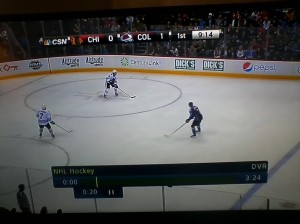
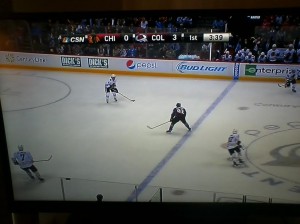
In both images, Keith and Seabrook maintain puck control while the Chicago forwards attempt to create a scenario in which they can receive a pass from Keith/Seabrook and either 1. enter the offensive zone with speed and control or 2. execute a strategic dump-in (see next paragraph).
Why Chicago’s PPS Leads To Success: Strategic Dump-Ins
There are a good deal of NHL teams whose first order of business when crossing the red line is to immediately dump and chase; Phoenix and Nashville, for example, come to mind. There is nothing inherently wrong with this strategy, to be sure – these teams are simply playing the style best suited to their rosters, and it certainly can lead to wins (Phoenix is 3rd in the NHL in points percentage and averages more goals per game than all but 3 other teams). Under a PPS like Chicago’s, however, dump-ins become less of a habit and more of a calculated move. Take a look:
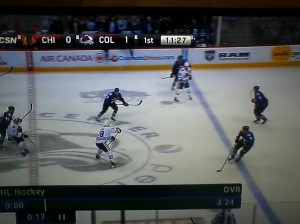
Toews, skating at full speed, is in the process of shooting the puck into the left corner of Colorado’s zone. The Avalanche defensemen are all flat-footed and Erik Johnson is the only one close enough to make a play on the puck once it arrives in the aforementioned corner. Toews dumped the puck there for a specific reason: It would allow both him and Patrick Sharp (standing near the top of the image) to forecheck and consequently outnumber the Avalanche, as Johnson is the only Colorado player in position to challenge Toews and Sharp. The probability of the Hawks regaining control of the puck in this scenario is quite high.
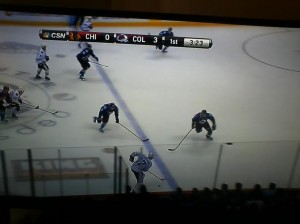
Conceptually similar to the example described previously. Brookbank dumps the puck into the right corner from the blueline, giving Andrew Shaw (at full-speed, left-middle) and Kris Versteeg (top, above Chicago icon) a 2-on-1 forechecking advantage against Colorado’s Tyson Barrie (top, partially obscured by Colorado icon). Again, the odds of the Blackhawks regaining possession are high.
Why Chicago’s PPS Leads To Success – Offensive Zone Positioning
It’s often difficult to maintain possession for very long in the offensive zone due to the simple reality of having 11 large human beings in one relatively small area. In a system that emphasizes possession, then, it is vital to ensure that the puck-carrier always has options. Let’s see it in action:
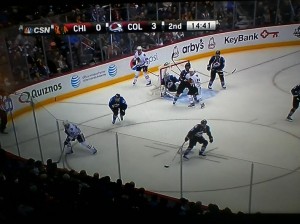
Bollig has the puck in the lower part of the image. He has 2 viable options – he can either ring it around the boards to Saad behind Colorado’s net, or he can chip it back to Leddy at the left point (not pictured). Chicago has achieved the maximum offensive versatility possible in this situation; there is the potential for a shot on net with traffic (pass back to Leddy and shoot) as well as further cycling (pass to Saad, Shaw leaves the front of the net to provide support). Whatever Bollig chooses to do, Chicago will maintain pressure in the offensive zone. This is ideal.
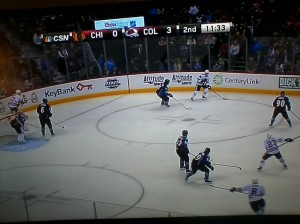
In this case, Kane has 2 options. He can cycle the puck back to Pirri (left, behind the net) or wait a half second and pass to Versteeg (right-middle) for a potential scoring chance. This image depicts good but not great offense – Leddy is in no-man’s land at the left point, and in a 3-0 game with his team in firm possession of the puck, should have been much deeper in the zone to offer Kane a chance to pass right to the front of the net for a high-quality scoring chance. Kane had picked up the puck in the corner near the “NHL Network” logo on the boards, so Leddy had ample time to get in the right position. Kane has several options in this image to maintain Chicago possession, and in that sense this is still effective offense – but Leddy’s mental mistake nevertheless holds it back.
Potential Flaw in Chicago’s PPS – Personnel
No team’s roster is perfectly tailored to the system it plays, and Chicago’s is no different. Take a look:
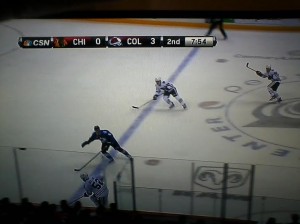
I have grown to like Bollig as a player after being pretty sour on him for most of his NHL career with the Hawks, but there’s no denying that his skillset doesn’t really fit into Chicago’s possession scheme. In this case, he dumped the puck in instead of pursuing the very-much-available 3-on-1 with Shaw and Ben Smith. Bollig tends to make bad decisions with the puck and is fairly slow on his feet. His best asset is his fighting ability, but that’s been rendered mostly useless in today’s NHL – and especially on a heavily skill-oriented roster like Chicago’s. Having Bollig at wing on the fourth line instead of, for example, Jeremy Morin (a better fit for the Blackhawks’ system) probably isn’t going to mean the difference between winning and losing the Cup come June… but one could quite easily argue that it at least made a huge difference in this particular game against Colorado. The 2-on-0 that Bollig could have engendered with a simple pass to Smith (middle) would have had a very high chance of getting the Hawks on the scoreboard and making it a 3-1 game. Coming back from a two-goal deficit is very doable with almost 28 minutes to work with (as Chicago would have had). Instead, Bollig dumped the puck into the corner and Chicago gave up another goal to go down by 4 en route to a 5-1 loss.
Potential Flaw in Chicago’s PPS – Indecision Concerning Aggressiveness
This especially applies to defensemen. The situation below occurred 8 seconds before Colorado’s fourth goal of the night.
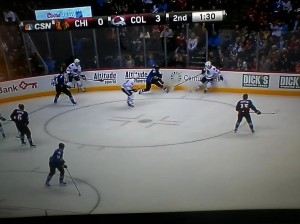
Hjalmarsson (top, to the right of the ice spray and puck) was not necessarily wrong to pinch here – the Hawks still hadn’t scored a goal in the game and were down by 3. However, he was hesitant in doing so, and this is where problems arose. Hjalmarsson skated at half speed toward the puck on the boards, very apparently second-guessing his decision to be aggressive even as he kept skating towards the loose puck. He poked at the puck with one hand on his stick and missed, and then – realizing he was in trouble – attempted to kick it past Paul Stastny (top, to the left of the ice spray and puck). This failed, Stastny made an easy breakout pass to P.A. Parenteau, and Parenteau scored on the ensuing 2-on-1. The problem here is Hjalmarsson’s indecisiveness – had he gone after the loose puck near or at full speed and with both hands on his stick, he would have been able to knock it back behind the Avalanche net with relative ease and maintain offensive pressure for the Hawks. But he was second-guessing his decision to pinch as soon as he made it, and this ultimately led to Colorado’s fourth goal of the night.
Is There a Way to Measure Puck Possession?
Not directly, no, unless someone’s interested in grabbing a stopwatch and pressing the start and stop buttons for hours. But there are some really good advanced metrics that can indirectly measure possession, and as you’ll learn if you continue to read me, I have a slightly unhealthy love for them. The stat I like best is called Fenwick – or, more specifically, Fenwick Close (FC).
Say we have a Team A. For Team A, Fenwick is a stat that compares all shots that Team A directs toward the opposition’s net versus all shots that opposing teams direct toward Team A’s net. Blocked shots are excluded. Fenwick Close (as opposed to just Fenwick) is only tracked when the score is within one goal in the first and second periods and tied in the third period and overtime. FC has these tracking restrictions because when a game is not close, puck possession numbers tend to vary independent of a team’s “real” possession ability. A team leading by three goals, for example, will tend to relax its forecheck and play a more defensive-oriented style in order to maintain the lead. This would artificially deflate their possession numbers. FC is a useful and quite accurate proxy for puck possession, time in the attacking zone, and scoring chances. Chicago currently has the highest Fenwick Close in the NHL.
A final note: Chicago has played its two worst games of the season within the past week (@Colorado, @Nashville), and both of them were without Marian Hossa – an absolutely elite possession player due to his strength on the puck and two-way ability. Food for thought.
Comments are closed.